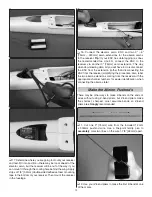
22
After you land, always use a LiPo battery checker (GPMM3205)
to check the individual cell voltages of your battery. The “resting,”
“open” voltage of each cell when the batteries “recover” a few
minutes after your fl ight should be no less than 3.7V per cell
(which also equates to 20% capacity remaining). Adjust your
timer accordingly so as not to over discharge your batteries.
Also note the capacity that goes back into your battery after
a charge. The battery should take no more than 80% of its
capacity to recharge (indicating that no more than 80% was
used during the fl ight). Again, adjust your fl ight time and set
your timer accordingly.
Lateral Balance
To perform a “pylon” turn,
bank the wing vertically
and pull full, low-rate elevator.
Eventually, when you begin fl ying more frequent, high-
speed “pylon-style” turns, you’ll want to make sure the Rifl e
is laterally balanced and turns correctly. When performing
a full-throttle pylon turn, roll the wing vertically, then pull full
(low-rate) elevator. Notice whether the plane rolls in either
direction with the application of only elevator. If the high wing
rolls out of the turn it will probably also yaw upward resulting
in an increase in altitude. In this case the high wing is heavy
and ballast should be added to the low wing. If the plane
does the opposite—the high wing rolls into the turn and the
fuselage yaws downward—the low wing is heavy and weight
needs to be added to the high wing.
Ballast such as shot or strips can be added to the wing simply
by using a Dremel tool or even a hobby knife to carefully cut
a small section from the bottom fi berglass wing skin at the tip,
then removing the foam and installing the weight with epoxy.
Summary of Contents for Rifle 1M
Page 24: ......



































